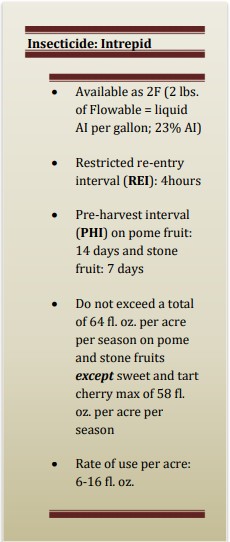Reduced Risk Insecticide: Intrepid
Intrepid is registered for use in Wisconsin on pome fruits, including apple, crabapple, pear, loquat, and quince as well as stone fruits, including apricot, sweet and sour cherry, nectarine, peach, plums, pluot, plumcot, and prune. It has been registered with EPA since 2000. It is marketed by Dow AgroSciences under the formulation 2F (2 lbs of active ingredient per gallon, Flowable). Similar to Confirm, Intrepid is an Insect Growth Regulator (IGR) with the active ingredient methoxyfenozide (IRAC code 18, class of diacylhydrazines). It mimics the action of a natural insect hormone that induces molting in lepidopterous larvae. It is highly active against most lepidopterous larvae by inducing premature lethal molt primarily after ingestion from treated crop surfaces. Feeding generally ceases within hours of ingestion and affected larvae will often become lethargic and discolored. The larvae may take several days to die. Intrepid is very selective to Lepidoptera larvae and should pretty much have no effect on other insect orders.
Intrepid 2F is registered on for control of lesser appleworm, oriental fruit moth, codling moth (suppression only), oblique banded leafroller, pandemis leafroller, eyespotted bud moth, fruittree leafroller, light brown apple moth, redbanded leafroller, variegated leafroller, tufted apple bud moth, spotted tentiform leafminer, western tentiform leafminer, lacanobia fruitworm, peach twig borer, European grapevine moth, omnivorous leafroller, threelined leafroller, cherry fruitworm, green fruitworm, and redhumped caterpillar.

Intrepid 2F may be applied by ground equipment and by air (see label for specific application regulations). For ground applications, conventional ground sprayers need to be calibrated to deliver a minimum of 50 gpa to trellised trees or trees 10 feet tall or less and 100 gpa to trees taller than 10 feet to ensure thorough coverage. For pome fruit, aerial applications are allowed only for the last two applications prior to harvest.
A chemical is considered toxic to bees if its toxicity (measured as the LD50 or Lethal Dose required to kill 50% of the test population) is below 11 μg/bee. Intrepid has an LD50 of 100μg/bee, thus it is not considered toxic to bees. While Intrepid is considered safe to spray during bloom, as a general rule, avoid spraying when bees are actively foraging and concentrate your spraying outside of the bloom period. If you need to apply Intrepid during bloom, plan to apply earlier or better yet later in the day.
Drift or runoff from applications of Intrepid 2F may be hazardous to sensitive aquatic invertebrates. Do not apply directly to water. As always, make sure to read the label before using any pesticide. You can find the label of Intrepid 2F by clicking here or by copying this address in your browser: https://greenbook-assets.s3.amazonaws.com/D02-846- 009_Intrepid_2F_Specimen_Label.pdf
This article was posted in Insects and tagged Intrepid.
